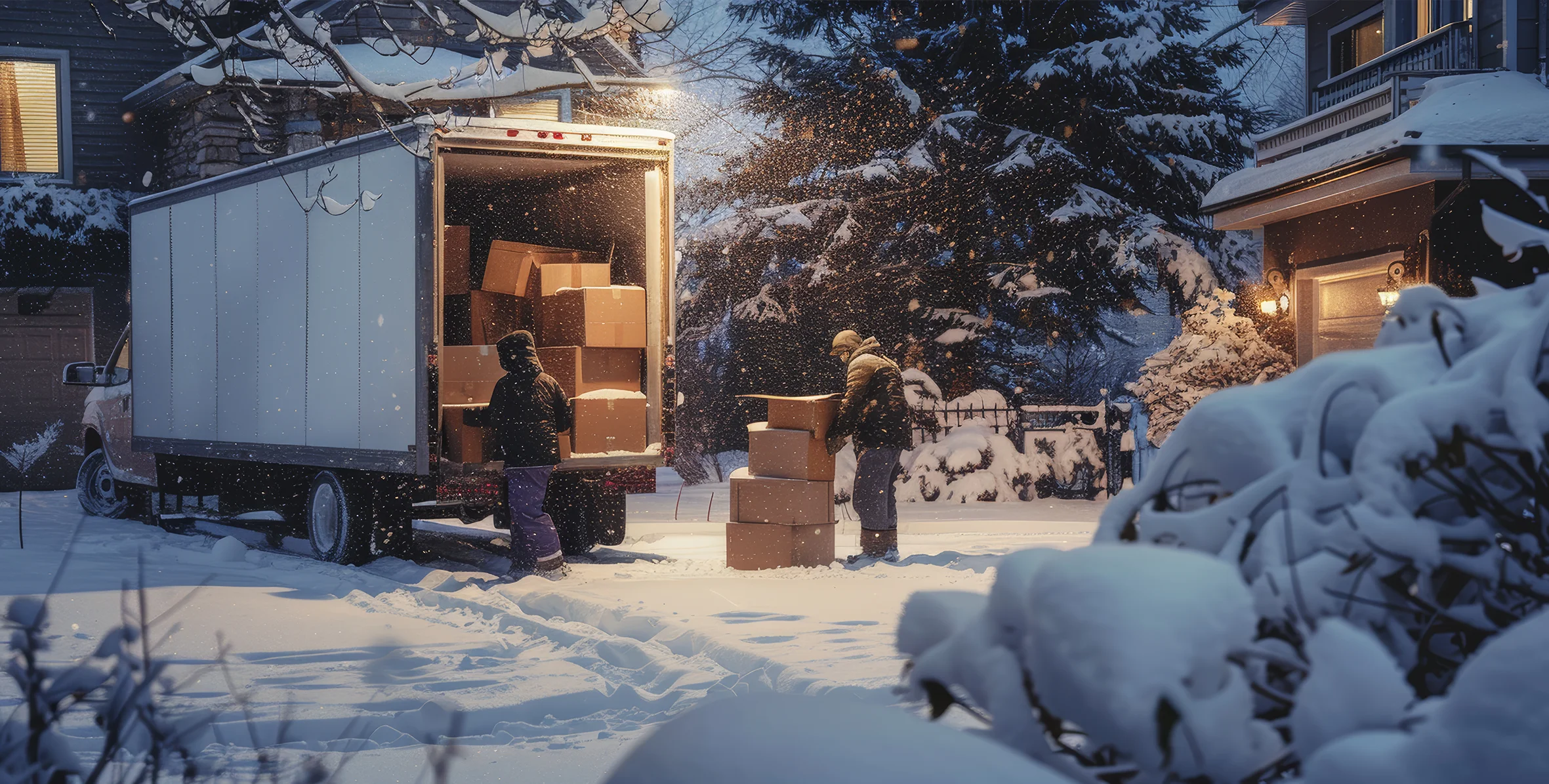If you wait for perfect weather, you’ll never get anything done.
That old saying feels especially true when you’re staring at a snow-covered driveway and trying to figure out how to move from one home to another. Moving in winter doesn’t sound ideal. It’s cold, messy, unpredictable, and can sometimes feel like a logistical nightmare.
But most people don’t talk about the fact that winter may actually be one of the smartest times to move, if you know how to do it right.
According to the U.S. Census Bureau, while most people wait for the warmer months, roughly 10–12% of moves happen during the winter. Why? Because it can save you money, offer more flexibility with mover availability, and help you skip the chaos of peak moving season.
But winter moving isn’t as simple as bundling up and loading boxes. There are real challenges, and that’s exactly why you need the right guidance.
In this guide, we will discuss the most essential and practical winter moving tips that help you get from point A to B without stress.
Whether you’re trying to plan around unpredictable weather or just want to know how to pack items in cold weather without damaging them, we’ve got you covered.
Moving during the winter months is a completely different experience compared to a spring or summer move. It’s not just about the cold; everything from how you plan your day to how you pack your belongings changes when snow and freezing temperatures are involved.
If you’re wondering why people treat winter moves differently, here’s exactly what sets them apart.
The biggest factor is the weather. Snow, ice, freezing rain, and wind can slow down the entire process. Roads can be slippery, driveways need shoveling, and unexpected storms might delay your schedule. That’s why weather planning becomes one of the most important things you’ll do.
In winter, daylight fades quickly. Depending on where you live in the U.S., you might only have 8–9 hours of good daylight to work with. That’s much less time than a summer move, and it means starting early is crucial.
Your belongings are more sensitive to cold temperatures than you might think. Electronics, glassware, and other delicate items can crack or malfunction if they’re exposed to freezing temperatures. You’ll need extra padding and insulated boxes.
Slippery sidewalks, icy stairs, and wet floors increase the chance of accidents. That’s why it’s so important to protect floors and stairs during a winter move. Whether you’re hiring movers or doing it yourself, keeping everyone safe is a top priority.
Unlike in summer, you can’t just show up at your new place and start unpacking. If the heat isn’t on yet or utilities haven’t been set up, your new home might be freezing when you arrive.

Planning is the most important part of a successful winter move. Since you’re dealing with unpredictable weather and colder conditions, the more prepared you are, the smoother things will go.
Here’s how to prepare the right way.
Start monitoring the weather about a week before your move. Snowstorms or icy roads can throw off even the best plans. Always have a backup moving day in case conditions get too dangerous.
Not all moving companies are equipped for winter conditions. Choose movers who know how to work safely in snow and cold. Book early, as winter crews may have limited availability despite being less busy than peak season.
Using a clear winter checklist helps keep things organized. Include tasks like confirming your movers, prepping supplies, turning on the heat, and checking weather updates. It’s a simple way to stay on top of every detail.
Make sure both your current and new homes are ready for winter conditions. Clear snow and ice from walkways and driveways, and lay down mats or cardboard indoors to protect floors and stairs from water and dirt.
Never move into a cold, unheated home. Confirm your utilities and heating are active and working at least a day before your arrival. This makes unpacking easier and keeps everyone warm from the start.
Keep a small kit with cold-weather essentials: blankets, gloves, snacks, water, a flashlight, and a phone charger. If there’s a delay or you get stuck in traffic, you’ll be glad you had it ready.
Cold weather adds a few extra steps to keep your belongings safe and your move running smoothly. Here’s how to prep your space the right way.
Before the movers arrive, shovel any snow and apply salt or sand to walkways, stairs, and the driveway. This helps prevent slips and injuries while carrying heavy items.
Wet boots, melting snow, and muddy footprints can cause damage to your floors and create slipping hazards. Lay down tarps, old blankets, or non-slip mats to protect floors and stairs during a winter move.
Keep one entrance cleared and designate it as the main path for moving. Close off other doors and use towels or door draft stoppers to keep cold air out.
Don’t wait until move-in day to think about heating. Make sure your utilities and heating are turned on at least 24 hours in advance so the house is warm when you arrive. It’s especially important if you’re moving with children, pets, or older adults.
Place plastic sheets or towels near entrances to catch melting snow and water. Have extra towels or paper towels on hand to wipe down wet boxes and surfaces.

From temperature-sensitive items to slippery conditions, packing for a winter move requires a little more care than usual. Here’s how to keep everything safe from the cold, moisture, and damage.
Use strong, waterproof boxes or plastic bins when possible. Wrap items in plastic wrap or garbage bags before placing them in cardboard boxes to protect them from moisture.
Glass, electronics, and ceramics become more brittle in freezing temperatures. Wrap them with bubble wrap, towels, or blankets and label them clearly. Keep them indoors until just before loading and avoid placing them directly against the cold walls of the moving truck.
Set aside a box with winter essentials: gloves, chargers, hot drinks, toiletries, medications, and a few warm clothes. Keep it with you instead of in the truck.
Lift boxes carefully to avoid slipping on icy surfaces. Stack heavier items on the bottom and avoid overpacking boxes that could burst if they get wet or are dropped.
If you’re transporting electronics, musical instruments, or anything easily damaged by the cold, don’t leave them in the truck for long. Pack them last, unload them first, and consider keeping certain items with you in your heated vehicle.
What you wear on moving day can make a big difference, especially in winter. You’ll be lifting, walking on icy surfaces, going in and out of cold and warm spaces, and possibly dealing with snow or wind.
Cold weather, limited daylight, and icy conditions all require you to approach the moving day differently. Here’s how to stay on track and move efficiently from start to finish.
Daylight fades faster in winter, so plan to begin as early as possible. The more you can get done while it’s light out, the better. This helps avoid working in the dark when it’s colder and visibility is low.
Even with careful planning, the weather can shift quickly. Snow or freezing rain might cause delays, so be ready to adjust. Keep in close contact with your moving company and have a backup plan.
Before the moving truck arrives, shovel and salt all walkways, steps, and driveways. This prevents accidents and helps movers work quickly and safely.
Designate a warm area inside where people can take short breaks. If your home is cold or still warming up, plug in a space heater (safely) or offer hot drinks.
Have a clearly labeled box or bag with snacks, water, gloves, chargers, medications, and other immediate needs. If the move takes longer than expected, you’ll have everything you need without digging through boxes.
| Feature | Winter Move | Summer Move |
|---|---|---|
| Cost | 20–30% lower rates, cheaper storage | Higher demand = higher cost |
| Availability | Easier scheduling, more flexibility | Bookings often weeks+ in advance |
| Weather challenges | Ice, snow, cold-sensitive items | Heat exhaustion, humidity |
| Fragility of goods | Items that are more brittle need extra padding | Less temperature risk to belongings |
| Daylight hours | Shorter — plan early | Full days available |
| Rental/housing bargains | Better deals October–April | More listings but higher competition |
Recommended Resources
How to Stay Cool When Moving in the Summer Heat
The Hidden Moving Costs You Didn’t Expect
Yes, moving during the winter is often cheaper. Because it’s the off-season for most moving companies, you can usually get lower rates and better availability compared to peak months like summer.
While it’s technically possible, it’s not recommended. Moving during a snowstorm can be unsafe due to poor road conditions and reduced visibility. If snow is in the forecast, postpone the move or have a backup date ready.
To prevent items from freezing, pack temperature-sensitive belongings like electronics or liquids in insulated containers and transport them in a heated vehicle. Avoid leaving them in the moving truck for extended periods.
Avoid packing electronics, candles, plants, and liquids that can freeze or get damaged by cold temperatures in the truck. Instead, transport them separately in a temperature-controlled vehicle.
Move plants in your personal vehicle where it’s warm. Wrap pots with blankets or towels for extra insulation and avoid placing them near cold windows or vents. Limit exposure to freezing temperatures during loading and unloading.